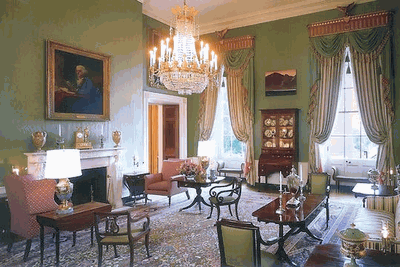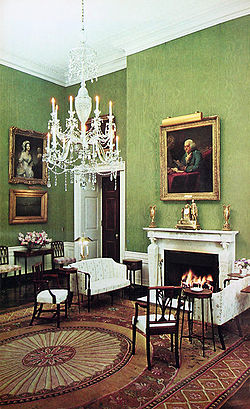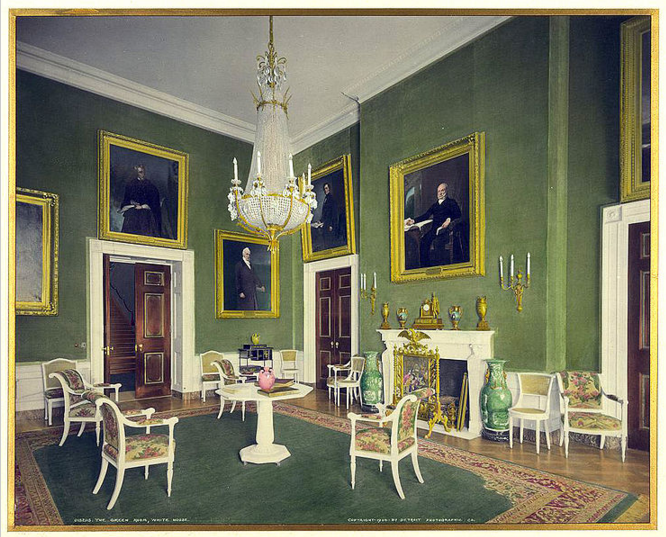2009: Obama Administration

Carpet Description
- Savonnerie
- French European
The Green Room is one of three state parlors on the first floor in the White House. During a state dinner, guests are served cocktails in the three state parlors before the president, first lady, and visiting head of state descend the Grand Staircase for dinner. The room is traditionally decorated in shades of green.Over the years, presidents and first ladies have used the Green Room as a small parlor for hosting guests and encouraging informal conversation. Helen Taft, the wife of President William Howard Taft, described the Green Room as her favorite.
A Brief History of Savonnerie Carpets
The early history of carpets in France is tied to the story of two weaving ateliers, Savonnerie and Aubusson. There are earlier references to carpets being woven in France before the seventeenth century, but no examples survive.
The granting of a license by Henri IV to Pierre Dupont in France, 1608, to manufacture Savonnerie carpets is similar in spirit to the establishment of court workshops by the Mughals and Safavids, whose common aim was to produce superlative works of art, including carpets. In 1627 Louis XVIII gave a royal privilege to Dupont (1577-1640) and his pupil Simon Lourdet (d.1671) for weaving carpets. They set up business in an old soap factory, hence the name Savonnerie, which quickly became the label attached to the products of the factory - carpets, panels and wall hangings - all created exclusively for the court. From the beginning, individual designers were employed to create designs, all of which were European in style.
Unlike early American or British carpets, no attempt seems to have been made by the Savonnerie atelier to emulate oriental carpets. A law was passed to prohibit the importation of carpets from the East to France in order to safeguard the Savonnerie workshop, which was granted a monopoly for the weaving of knotted-pile carpets. The seventeenth-century Savonnerie carpets have an opulent grandeur associated with them. Until 1768 the factory worked chiefly, if not exclusively, for the court, producing pile carpets only.
The richness of the colours used and the supremely confident manner with which acanthus scrolls, classical motifs and floral motifs were handled, combined to create a sumptuous effect worthy of any royal household. In 1663, Colbert, one of Louis XIV's ministers, stipulated that a painter from the Royal Academy had to oversee the designs for the carpets and to teach drawing to the staff every month. Several important painters were associated with Savonnerie in this way, notably Charles Le Brun and, later in the eighteenth century, Francois Boucher.
Austere state economies, due to the financial problems arising from the wars in the latter part of Louis XIV's reign, were largely responsible for the decline of the factory between 1690 and 1712. However, it was later revived and produced very pretty feminine carpets akin to the prevailing styles in the other decorative arts of the era. Soft colours, delicately drawn flowers, floral swags and ribbons are typical. Its heyday was over and by the beginning of the nineteenth century, cheaper Aubusson carpets became popular, although Napoleon employed the factory to weave handsome Empire-style carpets. In 1825, Savonnerie was amalgamated with the Gobelins tapestry factory and its independent existence came to an end. To read more about french style rugs and their history, visit our French Rugs section.
2007: Bush Administration

Carpet Description
- Persian Bidjar
- Late 4th quarter 19th century
- Border is a flowing vine with palmettes
- Field has fantastic top color of aqua blue
In 2007, First Lady Laura Bush, in collaboration with the Committee for the Preservation of the White House, Bush family interior designer Ken Blasingame, and White House curator William Allman, refurbished the Green Room.The refurbishment retained most of the Nixon-era Conger and Vason Jones design. In this refurbishing, colors were updated and intensified, the moiré pattern of the silk walls becoming darker and the furniture and draperies were changed for a near-vermilion shade. The drapery recreates Edward Vason Jones' 1971 design but with the more intense vermilion in the silk and the painted cornice. The drapery design was simplified by removing four large tassels but retained the large bobble-fringe of the Nixon-era design. The green Turkish Kilim carpet installed in the Nixon administration was replaced by a late 19th century Persian Bidjar rug. Its design somewhat resembles an antique Savonnerie acquired for the Red Room by Stéphane Boudin. This room contains the only two paintings by African-American artists in the White House permanent collection, "Builders" and "Sand Dunes at Sunset, Atlantic City," both by Henry Ossawa Tanner.
Bidjar rugs
Carpets made in the Bidjar area in Northwest Persia are the most robust of any oriental carpets, due to their characteristic weaving technique of beating the weft into place with a long iron bar, which is inserted between the warps during weaving, then pounded against the wefts. These carpets are among the finest of Persian rugs by virtue of their design and construction. The quality of their wool is lustrous and soft. The designs vary, some are typical nineteenth-century Persian in style and produced in a rectilinear format. Others carry drawings that are classically precise or wildly tribal including pictorial or garden patterns. Red or cream grounds combined with a strong light or dark blue are typical. Synthetic dyes were not introduced in Bidjar carpets until after the First World War. They are distinguished primarily by their weave, which is perhaps the densest and most durable of all oriental rugs. Because of their great strength, they are suitable for areas of heavy wear in the home, such as hallways or landings. Bidjar carpets were made in a variety of sizes.
1964: Kennedy Administration

Carpet Description
- Aubusson
Above is a picture of the White House Green Room in 1964, looking northeast, showing decor adopted during the administration of John F. Kennedy, and with a chandelier substitution made at the request of new first lady Lady Bird Johnson. In 1902 a major renovation, guided by historical research, was implemented by the architectural firm of McKim, Mead, and White. Layers of complex Victorian ornamentation were replaced by a style called Colonial Revival which was more similar to how the house was initially furnished. Heavily patterned floral wall covering was replaced by a simple green silk velvet. The c. 1852 Renaissance Revival mantel was replaced by a French Empire mantel purchased by President Monroe in 1819. A suite of reproduction French Directoire upholstered chairs and white painted caned reproduction English Regency furniture replaced a suite of overstuffed Turkish style sofas and chairs. Subsequent twentieth century presidents mostly maintained what could be described as an "Colonial" appearance with largely reproduction furniture. President Kennedy considered the Green Room to be the most attractive and restful room on the state floor.
A Brief History of Aubusson Carpets
Aubusson carpets are fine carpets woven in France dating from the 15th to 19th centuries. Aubussons were crafted with the assistance of architects and artists of the French royal court. They were originally made in France as a pileless carpet with a floral medallion in pastel colors.
Today's Aubusson's are woven in India and China and have been adapted by the addition of a pile. The Aubusson area was best known as an important tapestry-weaving center until, in an attempt to meet the great demand for knotted carpets, the King's Council set up a carpet-weaving enterprise there in the early 1740s. Initially the carpets were copies of imported Turkish designs. Louis XV and Madame de Pompadour were among the first clients, placing orders through agents in Paris. Sadly, the demand for oriental rugs did not last and the artist Pierre-Jose Perrot, who had already been involved with designing Savonnerie carpets, was called upon to design carpets in the French style in 1750.
Another painter, Le Lorrain, produced a radical new design, "a grande mosaic", which was a sophisticated precursor to the 19th century floral carpets. A central medallion of flowers is surrounded by dainty rosettes, flowers and garlands. Aubusson carpets were originally made as both knotted-pile carpets and later in the 18th century as flat woven slit-tapestry technique carpets produced in the same way as their tapestries. The Aubussons that are popular and readily available today are typically flat weaves.
The Aubusson floral tradition was never completely abandoned, although the trend began to lean towards the neo-classical Empire style created by two architects (Percier and Fontaine) after the Proclamation of the French Empire in 1804. That gave rise to elegant Savonnerie and Aubusson carpets whose patterns are influenced by antique classical trophies or Etruscan and Roman motifs. These tend to be in a dark rich palette, sometimes in different shades of the same colour, resulting in a multi dimensional look.
Nineteenth-century Aubusson tapestry-woven carpets, which were produced in great quantities, are popular today with interior decorators in Europe and North America. Trailing ribbons, bows and blowsy roses woven in soft pastel shades- of rose, dovey greys, cafe-au-lait and pale yellows conjure a very feminine look well suited for sitting rooms and bedrooms. Seventeenth and eighteenth-century Aubusson carpets in good condition are finds. As such an Aubusson in good condition garners a high price. To learn more about French rugs and their history, visit our French Rugs section.
1904: Roosevelt Administration

Carpet Description
- Persian Kerman Carpet
The White House Green Room in 1904 following a major renovation by interior designers McKim, Mead, and White during the administration of Theodore Roosevelt. In 1902 a major renovation, guided by historical research, was implemented by the architectural firm of McKim, Mead, and White. Layers of complex Victorian ornamentation were replaced by a style called Colonial Revival which was more similar to how the house was initially furnished. Heavily patterned floral wall covering was replaced by a simple green silk velvet. The c. 1852 Renaissance Revival mantel was replaced by a French Empire mantel purchased by President Monroe in 1819. A suite of reproduction French Directoire upholstered chairs and white painted caned reproduction English Regency furniture replaced a suite of overstuffed Turkish style sofas and chairs. Subsequent twentieth century presidents mostly maintained what could be described as an "Colonial" appearance with largely reproduction furniture.
History of Kerman rugs
Situated in south-east Persia, Kerman (Kirman) was one of the towns where the Safavids, descendants of the Sufi shaikhs, set up a court atelier. It has remained an important centre of carpet production ever since, particularly over the last century. An interesting influence during the nineteenth century was the town's tradition of woolen shawl production. Many local weavers produced beautifully woven shawls decorated with designs based on the floral-cone motif, the boteh, known in Europe as paisley style. As the demand for shawls declined, partly explained by the fact that by the late nineteenth century, similar shawls were being produced in Paisley, Scotland, the weavers were smart enough to adapt their skills to the increasingly popular skill of carpet weaving to successful results. Not surprisingly, the floral-cone motif is frequently seen in Kerman carpets in numerous permutations. It is often hard to pinpoint exactly what constitutes a Kerman design, as the motifs and patterns used are typical of many centres of Persian carpet production. Floral medallions and corner motifs are popular, as are flowering tree patterns and pictorial hunting designs. Pale washed-out colours such as beige and white are typical. The Lavar Kerman is a very finely knotted large piece, with an unusual overall small floral pattern on an ivory field. Lavars are a particular kind of Kerman which, although quite rare, are famous for the superb quality of the weave. Typically woven in pinky colours, Lavars are very popular in America.
Sources and inspiration: Bérinstain, Valérie, et al. L'art du tapis dans le monde (The art of carpets in the world). Paris: Mengès, 1996. Print.; Jerrehian Jr., Aram K.A. Oriental Rug Primer. Philadelphia: Running Press, 1980. Print.; Herbert, Janice Summers. Oriental Rugs, New York: Macmillan, 1982. Print.; Hackmack, Adolf. Chinese Carpets and Rugs, Rutland and Tokyo: Tuttle, 1980. Print. ; De Moubray, Amicia, and David Black. Carpets for the home, London: Laurence King Publishing, 1999. Print.; Jacobsen, Charles. Oriental Rugs A Complete Guide, Rutland and Tokyo: Tuttle, 1962. Print.; Bashir, S. (n.d.). Personal interview.; Web site sources and dates of consultation vary (to be confirmed). Without prejudice to official usage.
Place an Order
We can reproduce any carpet shown on this page in the size and colors of your choice. For more information or to place an order, call us at +1-514-735-1958 from Monday to Saturday between 10 am and 5 pm Eastern standard time or feel free to e-mail us at [email protected]


 Tapis d'Orient Bashir | Bashir Persian Rugs
Tapis d'Orient Bashir | Bashir Persian Rugs
 @tapisbashir
@tapisbashir
 @bashircarpets
@bashircarpets
 @bashircarpets
@bashircarpets